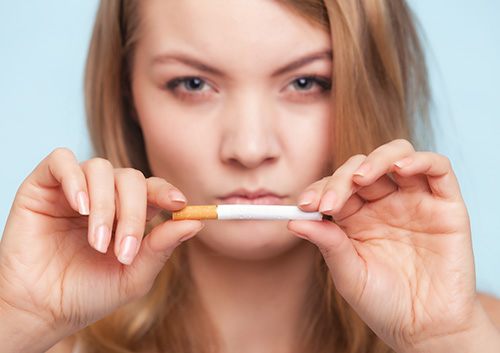Does smoking affect oral health?
August 8th, 2017

By now, everyone knows that smoking is bad for you. But the truth is its broad-reaching health effects are not all known by everyone. This is especially true of oral health. Smoking can have serious repercussions in this regard. To give you a better idea of how smoking can affect your oral health, Drs. Angela Paros, Amer Atassi, Eric Young, Alexander Katsnelson and our team have listed some issues that can arise.
Oral Cancer
Oral cancer can have steep ramifications for anyone that gets it. Surgery can be required to eliminate the cancer before it spreads to more vital parts of your body. Any type of cancer is about the worst health effect you can get, and this especially holds true to the affects that smoking has on your mouth. The type of mouth surgery required with oral cancer can leave your face deconstructed in certain areas, and it is all due to smoking or use of other tobacco products.
Tooth Discoloration and Bad Breath
At the very least, it is fair to say that as a smoker you will often have bad breath, and while you may try to cover it up with gum or mints, tooth discoloration is a whole other story. The chemicals and substances in cigarettes stick to your teeth staining them brown and yellow colors that are increasingly difficult to disguise.
Gum Disease and Loss of Bone
Another effect of smoking is the increased risk of gum disease. Your gums may start to recede, which can eventually lead to the loss of teeth. Smoking can also increase bone loss and density in your jaw which is vital to the health of your mouth. Gum disease and bone loss are two signs that smoking is definitely bad for your mouth.
When it comes to the health of your mouth, the question is not whether smoking affects your health, it's how does it affect your health and to what degree. If for no other reason than because smoking involves your mouth as its entry point, it is safe to say that it can have long-lasting and detrimental consequences on your oral health.
To learn more about smoking and your oral health, contact our Romeoville, IL office to schedule an appointment with Drs. Angela Paros, Amer Atassi, Eric Young, Alexander Katsnelson.
Relax with Sedation Dentistry
August 1st, 2017

Drs. Angela Paros, Amer Atassi, Eric Young, Alexander Katsnelson and our team at High Point Dental Group understand that many of our patients have a fear of dentistry. You may be concerned about experiencing pain from sensitive teeth or routine procedures. General anxiety is also common. Do not put off visiting our Romeoville, IL office; we offer various types of sedation to take the pain and fear out of your dental procedure.
Nitrous Oxide Sedation
For many patients, nitrous oxide, combined with local anesthetics, will both provide pain relief and reduce anxiety. Nitrous oxide is beneficial because the dosage can be regulated during treatment and patients are normally capable of driving shortly after the procedure is completed.
Oral or Injected Sedation
With oral sedation, you may be given a pill or liquid to consume several hours before your procedure. You will not be able to drive yourself to the appointment. An oral liquid is often given to children before any shots or intravenous anesthesia. An intramuscular injection may be given at the office that provides relaxation benefits for 20 to 30 minutes.
Nitrous Oxide with an Oral Sedative
If you experience higher levels of anxiety, an oral or injected sedative can be offered before nitrous oxide is started. This is also effective for reducing anxiety regarding the injection of local anesthetics. A liquid medication followed by nitrous oxide is beneficial for children. This combination can produce a deep sedation level.
General Anesthesia
This type of anesthesia can be offered as an inhaled gas or intravenous liquid. If no oral sedative is given before the general anesthesia is administered, you should wake up quickly after your procedure is complete. An injection, pill, or liquid medication can be offered to reduce anxiety before intravenous sedation begins. Intravenous sedation can also be used at moderate-to-deep sedation levels without complete loss of consciousness.
Do not hesitate to ask Drs. Angela Paros, Amer Atassi, Eric Young, Alexander Katsnelson about receiving sedation or pain prevention when you visit. We will be glad to explain the options we have available and answer all your questions to ensure that your exam is pleasant for you.
Top Five Dental Myths
July 25th, 2017

Sometimes the line between fact and fiction is easily blurred. This is certainly the case when it comes to dentistry, where myths and misconceptions abound. In a bid to put an end to health hoaxes, here are five dental myths to chew over.
Sugar Is the Number One Culprit of Tooth Decay
Sugar will rot your teeth. If you’re a parent, chances are you tell your children this every time they ask for something sweet. And chances are your parents told you the same thing. There’s no denying that sugar leads to cavity formation, but it's not the number one culprit of tooth decay. Sugar adds fuel to the fire, but it doesn’t light the match.
Going to the Dentist Is a Painful Experience
There are people who don’t go to the dentist because they think it’s going to be a painful experience. It’s time to put this myth to rest. New dental technology, developments in anesthetics and analgesics, and more conservative dental procedures have made visits to our Romeoville, IL office a more comfortable experience.
Bad Breath Means You’re Not Brushing
Poor dental hygiene can cause bad breath, but it’s not the only thing that will leave you looking for a breath mint. There are many factors that can cause bad breath, including illness, acid reflux, medication, and dehydration. In addition, sometimes what you eat or drink can give you bad breath no matter how many times you brush and floss. Next time you order a sub for lunch, skip the onions and garlic.
Bleaching Products Weaken Teeth
Gels, pastes, strips — there are all sorts of products available to make our pearly whites even whiter. If used according to the directions, bleaching products are harmless. They do not affect the health or strength of the teeth, only the color. At the same time, too much bleaching can cause temporary tooth sensitivity or irritated gums; the enamel, however, is not weakened.
You Will Know When You Have Tooth Decay
This is the type of false information that can lead to serious dental problems. There are no early symptoms of tooth decay. By the time you experience pain, your tooth decay has led to nerve damage, which means your decay is advanced and extensive. The only way to know if you have tooth decay —and to prevent it — is to visit Drs. Angela Paros, Amer Atassi, Eric Young, Alexander Katsnelson twice a year for a checkup and cleaning.
The Effects of Biting Your Nails
July 18th, 2017

Also known as onchophagia, the habit of nail biting is one of the so-called “nervous habits” that can be triggered by stress, excitement, or boredom. Approximately half of all kids between the ages of ten and 18 have been nail biters at one time or another. Experts say that about 30 percent of children and 15 percent of adults are nail biters, however most people stop chewing their nails by the time they turn 30.
Here are four dental and general reasons to stop biting your nails:
1. It’s unsanitary: Your nails harbor bacteria and germs, and are almost twice as dirty as fingers. What’s more, swallowing dirty nails can lead to stomach problems.
2. It wears down your teeth: Gnawing your nails can put added stress on your pearly whites, which can lead to crooked teeth.
3. It can delay your orthodontic treatment: For those of our patients wearing braces, nail biting puts additional pressure on teeth and weakens roots.
4. It can cost you, literally: It has been estimated that up to $4,000 in extra dental bills can build up over a lifetime.
Drs. Angela Paros, Amer Atassi, Eric Young, Alexander Katsnelson and our team recommend the following to kick your nail biting habit:
- Keep your nails trimmed short; you’ll have less of a nail to bite.
- Coat your nails with a bitter-tasting nail polish.
- Ask us about obtaining a mouthguard, which can help prevent nail biting.
- Put a rubber band around your wrist and snap it whenever you get the urge to gnaw on your nails.
- Think about when and why you chew your nails. Whether you are nervous or just bored, understanding the triggers can help you find a solution and stop the habit.
- If you can’t stop, behavioral therapy may be an effective option to stop nail biting. Ask Drs. Angela Paros, Amer Atassi, Eric Young, Alexander Katsnelson and our team for a recommendation.






